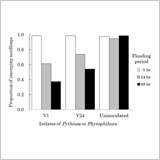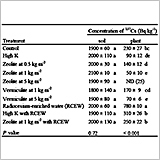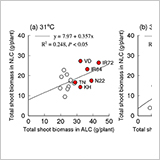Crop Morphology
Endosperm Structure of White-Belly and White-Core Rice Grains
Shown by Scanning Electron Microscopy
M. Xi, Z. Lin, X. Zhang, Z. Liu, G. Li, Q. Wang,
S. Wang and Y. Ding
- We use a japonica rice cultivar Wuyujing3 and its mutants.
- We select 12 representative photos from nearly 1000 SEM images.
- White-belly and white-core varied markedly in morphological features.
Abstract Full Text PDF[2225K] |
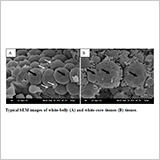 |
Morphological Evaluation of the Trace of Grain Detachment
in Japonica Rice Cultivars with Different Shattering Habits
K. Okubo
- In japonica rice cultivars, grain shattering pattern is related to shattering habit.
- Microscopic morphology of the trace of grain detachment is also related to shattering habit.
- These simple morphological characters show promise as marker traits in rice breeding.
Abstract Full Text PDF[2271K] |
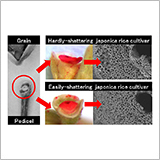 |
Effects of the Direction of Gravistimulation on Tuber Formation
and Amyloplast Distribution in Tuber Tips of Chinese Yam
M. Kawasaki, S. Kanehira and M.N. Islam
- Amyloplast sedimentation direction corresponded with direction of tuber elongation under different gravistimulation.
- In the rotated tubers at 90°, tubers have multiple tips and amyloplasts dispersed within the tip cells.
- The results supported the possibility that amyloplasts in tuber tips were involved in gravity sensing and tuber formation.
Abstract Full Text PDF[2334K] |
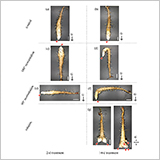 |
Crop Physiology
Effect of Ethanol on the Expression of Two Fructokinases
in Rice Seedlings
L. Guglielminetti and M. Volterrani
- Germination of rice (Oryza sativa L.) caryopses in the presence of exogenous ethanol results in a decrease of coleoptile and root growth.
- Exogenous ethanol under aerobic conditions induced the production of a fructokinase isoform (OsFK2) having a central role in the response of rice to anoxia.
- Our results suggest that rice can sense ethanol under anoxia and shows molecular response to oxygen deprivation.
Abstract Full Text PDF[705K] |
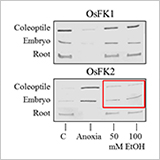 |
Phytotoxic Substances in Bangladeshi Allelopathic Rice BR 17
H. Kato-Noguchi, M.A. Salam and M. Morokuma
- Extracts of Bangladeshi rice BR 17 inhibited the growth of Echinochloa crus-galli with extract concentration dependently.
- Three phytotoxic substances, 9-hydroxy-4-megastigmen-3-one, 3-oxo-α-ionol and (-)-3-hydroxy-β-ionone were found in BR 17.
- The rice cultivar BR 17 may be potentially useful for weed management as a weed suppressing agent when this rice cultivar incorporated into the soil or included in a rice-based cropping systems.
Abstract Full Text PDF[599K] |
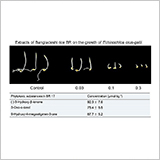 |
Agronomy & Crop Ecology
Effect of Pretilachlor on Weedy Rice and Other Weeds in
Wet-Seeded Rice Cultivation in South Vietnam
B.S. Chauhan, S.T.T. Ngoc, D. Duong and P.L. Ngoc
- Effect of pretilachlor (0, 300, 600 & 900 g ha-1) was studied on weedy rice and weeds in Vietnam.
- Weeds were effectively controlled by the lowest dose (300 g ha-1).
- Pretilachlor at 300 g ha-1 significantly reduced weedy rice panicles (20-69%) and biomass (15-26%).
- Highest dose (900 g ha-1) was better in reducing weedy rice panicles (47-80%) and biomass (41-54%).
Abstract Full Text PDF[509K] |
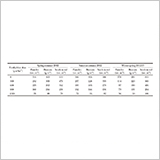 |
Weed Management in Dry-Seeded Fine Rice under Varying Row
Spacing in the Rice-Wheat System of Punjab, Pakistan
A. Khaliq, A. Matloob and B.S. Chauhan
- In partial weedy plot, 10-cm row spacing had 21-25% lower weed density than 20-cm spacing.
- In weed-free plot, 10 cm row spacing had 29% higher yield than 20-cm spacing.
- Narrow row spacing and sequential herbicide application can control weeds in dry-seeded rice.
Abstract Full Text PDF[1976K] |
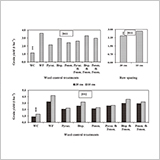 |
Decadal and Monthly Change of an Empirical Coefficient
in the Relation between Solar Radiation and the Daily Range
of Temperature in Japan: Implications for the Estimation
of Solar Radiation Based on Temperature
S. Hossain, K. Homma and T. Shiraiwa
- This study evaluated an estimation model for solar radiation in the view point of crop production.
- The empirical coefficient in the model varied among seasons and for decades, and the decadal change seemed to be caused by the global warming.
- Despite the seasonal and decadal bias, the model is considered to perform well.
Abstract Full Text PDF[3418K] |
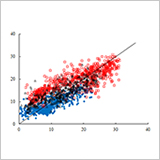 |
Productivity, Weed Dynamics, Nutrient Mining, and Monetary
Advantage of Maize-Legume Intercropping in the Eastern
Himalayan Region of India
V.K. Choudhary, A. Dixit, P.S. Kumar and B.S. Chauhan
- Highest maize (M) equivalent yield was in M intercropped with cowpea (CP) at row of 1M:2CP & 1M:5CP.
- Weed density and biomass were lowest in the plots of sole CP followed by 1M:5CP.
- NPK were removed less by weeds by intercropping M with CP than other legume at row of 1:5.
- Inclusion of legumes increased the uptake of nutrients by M.
Abstract Full Text PDF[865K] |
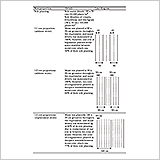 |










